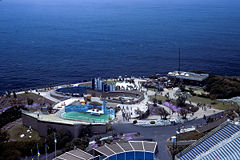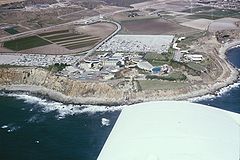- Marineland of the Pacific
-
Marineland of the Pacific was a public oceanarium and tourist attraction located on the Palos Verdes Peninsula coast in Los Angeles County, California, USA. Architect William Pereira designed the main structure. It was also known as Hanna-Barbera's Marineland during the late 1970s and early 1980s. Marineland operated from 1954 until 1987, when it was purchased by the owners of SeaWorld, San Diego. The new owners moved the popular killer whales and other animals to their San Diego facility and abruptly closed Marineland.
When it opened in 1954, one year before Disneyland, Marineland of the Pacific was the world's largest oceanarium. Many considered it California's first major theme park. Marineland was best known for its performing Orcas or "killer whales". It was also noteworthy for its Baja Reef concept, a first-of-its-kind swim-through aquarium featuring a wide array of sea life. Visitors could enter the winding aquarium wearing a swim mask and snorkel and swim with the fishes and sharks. Marineland also contained educational and research facilities, in addition to its unique entertainment structures.
Marineland was home to Orky and Corky, two of the most famous Orcas on exhibit at any oceanarium at the time. They should not be confused with the original Orky and Corky, who did not live long in captivity and had no calves. Marineland was also home to a pilot whale ("Bubbles"), dolphins, sea lions, harbor seals, sharks, and a variety of other related sea creatures. Marineland closed permanently in February 1987.
Contents
1987 Through 2007
After Harcourt, Brace, Jovanovich (the owner of the SeaWorld ocean park family) became the new owner of the property, Orky and Corky were moved to SeaWorld's San Diego facility, where Corky was given the new name of "Shamu". Although HBJ had promised to keep the Marineland Park open, they closed it six weeks after the sale was completed. Many local residents protested the sudden closing, but to no avail.
Much of the infrastructure was left abandoned for nearly 20 years. Marineland's most visible landmark, the 414-foot (126 m) high tower, remained standing until 1995. The Marineland Restaurant continued operating through 2004 as the "Catalina Room" (where Santa Catalina Island was visible on a clear day). Several other structures remained through 2006.
In 1995, developer York Long Point purchased 480 acres (1.9 km2) of coastal land that included the Marineland location for $24 million.
After several false starts, development began in 2007 on a new $450 million Terranea Resort, a project by Lowe Destination Development, which was planned to include a hotel, privately-owned "casitas", and full spa and resort facilities. Originally projected to include an 18-hole golf course, the plan was changed to include only an "Executive Par 3" course on the resort property.
In early 2006, two small temporary sales offices replaced the abandoned gas station at the park entrance and the large concrete sign along Palos Verdes Drive South (with a tower resembling a whale's tail) was altered to feature the Terranea logo and artist's rendering of the resort. In July 2007, principal construction work on Terranea Resort commenced, starting with the demolition of the remains of Marineland.
The Point Vicente Interpretive Center, located a half-mile north on the same road, reopened in July 2006 after an extensive remodel and has a number of items related to Marineland in an exhibit, including a "Save Marineland" pin and various publications from the park. One of the original dolphin statues that formerly adorned the entrance to Marineland is also on display.
Television, film and music
While still in operation, the park was prominently featured in several television shows, including two episodes of The Beverly Hillbillies, The Munsters, The Partridge Family, Hart to Hart, Emergency!, The Colbys and Sea Hunt. In one episode of the Lucy Show, Lucille Ball falls into a Marineland animal exhibit. In 1958, Dixieland jazz artist Red Nichols recorded a live album at Marineland. In an episode of Wonderbug, titled Fish Story, Marineland was integral to the plot. Marineland was also briefly featured in the Charles Bronson film, The Mechanic.
Since its closing, scenes for several feature films have been shot at the location, including all three Pirates of the Caribbean films, Charlie's Angels, Inspector Gadget, Fun with Dick and Jane, Pearl Harbor, The Aviator, Hidalgo, and Life As A House. For the latter, the suburban neighborhood exterior was entirely constructed from scratch on the site, as it was for Fun with Dick and Jane.
Several TV shows have also used the site for their filming needs, including regular use by NBC's Fear Factor and one episode of Viper. The location was also used for MTV's Motel California.
Further reading
- Patryla, Jim. (2005). A Photographic Journey Back To Marineland of the Pacific Lulu Publishing. ISBN 978-1-4116-7130-0.
See also
- Marineland - for other Marinelands
- Marineland of Florida - an earlier, unrelated oceanarium in Florida
- List of abandoned amusement parks
External links
- Marineland of the Pacific Historical Society
- Westways Article Whale Done
- Marineland of the Pacific Postcard Collection
- Marineland History City of RPV
- Satellite view from Google Maps
- Photo gallery of the abandoned location prior to demolition
- Coordinates: 33°44′19″N 118°23′55″W / 33.738585°N 118.398542°W
Zoos, aquariums, and aviaries Types of zoos Conservation Lists Animals Other topics - Animals in captivity
- Animal training
- Behavioral enrichment
- Captive breeding
- Frozen zoo
- Immersion exhibit
- Nocturnal house
- Wildlife conservation
- Zookeeper
- Zoology
- Portal
- Project
- Category
- Commons
Categories:- 1954 establishments
- 1987 disestablishments
- Defunct amusement parks in California
- History of Los Angeles, California
- History of Los Angeles County, California
- Buildings and structures in Los Angeles County, California
- Oceanaria in the United States
- William Pereira buildings
Wikimedia Foundation. 2010.






